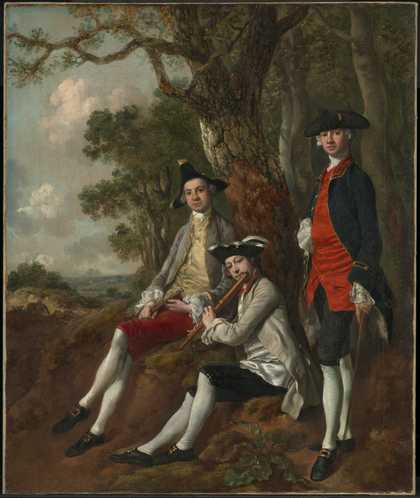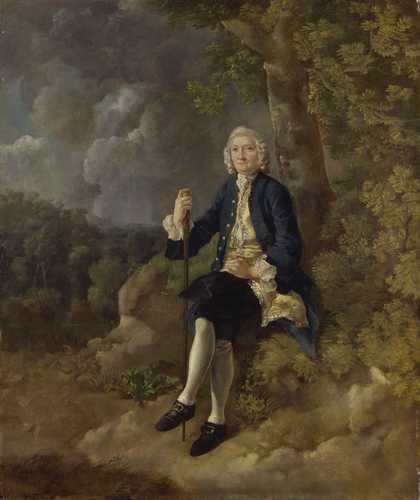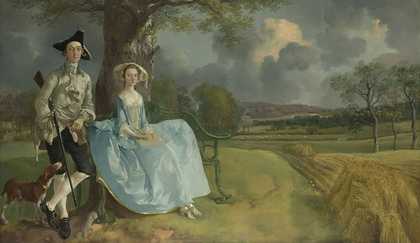
Fig.1
Thomas Gainsborough
Peter Darnell Muilman, Charles Crokatt and William Keable in a Landscape c.1750
Oil paint on canvas
765 x 642 mm
Tate T06746 / Gainsborough’s House
Photo © Tate
A small-scale portrait of three young gentlemen relaxing in a country setting, Peter Darnell Muilman, Charles Crokatt and William Keable in a Landscape c.1750 (Tate T06746; fig.1; hereafter Muilman, Crokatt and Keable in a Landscape) is a highly characteristic example of the kind of picture that Thomas Gainsborough painted at the commencement of his professional life. Depicted during a pause in a walk in the English countryside, two figures seat themselves companionably beneath an oak tree while a third stands to their right, with all three turning their heads to the viewer. Harmony and refinement pervade the scene as the central figure raises a transverse flute to his lips and plays.1 The flautist is William Keable, who was also a minor portraitist. The other figures are Peter Darnell Muilman and Charles Crokatt, the sons of two of the City of London’s most important overseas traders, although it is not known which sitter is Muilman and which Crokatt.2 With its bright pools of lucid colour and the freshness and sensitivity of its handling, the work is typical of the technique Gainsborough adopted in his late teens and early twenties for such intimate little group portraits, known at the time as ‘conversation pieces’. More or less exclusive to this phase of his career, works such as this have become emblematic of his initial output. Fixed under the rubric of ‘Early Gainsborough’ they have come to be habitually (and not always usefully) judged against a certain set of values and assumptions that have been accrued by that nomenclature from the late eighteenth century right up to the present.
Of course, there is no question that this picture is the work of a young man. At the turn of the 1750s, when Muilman, Crokatt and Keable in a Landscape was probably painted, Gainsborough was about twenty-three years old and based in his birthplace of Sudbury in Suffolk.3 At this stage, however, he had only recently re-established himself in this country town, having spent his teenage years learning his trade in London and, latterly, working independently as a landscape and portrait painter in Hatton Garden at the north-western edge of the City.4 A close working relationship is recorded with the painter Francis Hayman, whose portraiture served as an important model for his own, and also Hubert-François Gravelot, under whose influence Gainsborough appears to have acquired some of the finesse of the modern French rococo style.5

Fig.2
Thomas Gainsborough
Clayton Jones c.1744–5
Oil on canvas
762 x 635 mm
Yale Center for British Art, New Haven
The move back to Sudbury seems to have been part of a broader (and ultimately rather prolonged) effort to turn his talents and advantages to profitable effect. Greatly in his favour was the burgeoning reputation he had achieved as a painter of rustic Dutch-style landscapes over the course of the 1740s. The survival, furthermore, of a few ‘portraits in little’ from this time, which were already comparable in style and format to Muilman, Crokatt and Keable in a Landscape, also point to a measure of success as a metropolitan portraitist; for example, Clayton Jones of about 1744–5 (fig.2) is connected to this early London period. Another definite coup was his marriage in 1746 to Margaret Burr, who brought with her the very good annuity of £200 to which she was entitled as illegitimate daughter of the late 3rd Duke of Beaufort.6 Yet for all this progress, and a rather copious output of landscape compositions, it appears that Gainsborough found it difficult to afford life in the capital for himself and his growing family. Nor had a major aristocratic supporter materialised – so indispensable in that era for setting an aspiring portrait painter on the road to success. Like many an eighteenth-century portraitist setting out in the world, it was to his hometown, therefore, with its promise of established personal and commercial networks, that Gainsborough and his wife repaired in 1748. Muilman, Crokatt and Keable in a Landscape is therefore the work of a young but experienced professional – an acknowledged talent, but one that had yet to establish a firm place in the world.
It is almost exclusively within this biographical, life-and-works narrative that Muilman, Crokatt and Keable in a Landscape has been regarded by scholars and, to a great extent, valued. The picture’s perceived principal status as a particularly fine ‘Early Gainsborough’ was at no time more apparent than in 1993 when the portrait was purchased jointly by Gainsborough’s House, Sudbury, and Tate. In the institutional paperwork generated by both organisations at this point, the degree to which the work’s authorship was identified as its premier claim to national significance is remarkable. A press release on the acquisition issued by Gainsborough’s House highlighted that it was ‘vital’ that Britain’s public holdings of art should amply ‘represent this significant moment in Gainsborough’s development’.7 A curatorial report written for Tate’s Board of Trustees elaborated on this same issue, observing that of ‘all the great masters of the British School, Gainsborough’s career exhibits the greatest range of development from youth to maturity, and each of his three distinct periods – Suffolk, Bath and London – has produced its own masterpieces’, stating further that ‘There can be no doubt that the Muilman Group is one of these.’8 Tellingly, a slim pamphlet on the picture that was distributed among members of Tate Patrons of British Art in 2002 was given the title An Early Gainsborough Masterpiece: Thomas Gainsborough’s ‘Portrait of Peter Darnell Muilman, Charles Crokatt and William Keable in a Landscape’.9

Fig.3
Thomas Gainsborough
Cornard Wood, near Sudbury, Suffolk 1748
National Gallery, London
These repeated references to the portrait’s significance as an illustration of Gainsborough’s youthful ‘development’ are indicative of the dominant, and subtly ambivalent, regard in which works of ‘Early Gainsborough’ have been held; that is to say, as the achievements of an acknowledged master, certainly, yet qualified de facto by their antecedence to the ‘mature’ Bath period (c.1760–74) and second London period (1774–88). In his foreword to the 1997 catalogue for the Young Gainsborough exhibition at the National Gallery, London, the gallery’s then-director Neil MacGregor wrote of the ‘beguiling, if not entirely resolved’ quality of Gainsborough’s early landscapes and portraits as exemplified by Cornard Wood, near Sudbury, Suffolk 1748 and Mr and Mrs Andrews c.1750 (figs.3 and 4), and of the primary significance of the exhibition as an ‘incomparable view of Gainsborough before thirty’;10 of the man, therefore, rather than his creations.

Fig.4
Thomas Gainsborough
Mr and Mrs Andrews c.1750
National Gallery, London
Also typical of the institutional discourse on ‘Early Gainsborough’ is the backhanded wording of the 1993 Tate curatorial report, which recommended Muilman, Crokatt and Keable in a Landscape for acquisition for the way it ‘represents to perfection [Gainsborough’s] early efforts to meld the graceful Rococo nonchalance of the conversation piece with the gentle, atmospheric qualities of his native Suffolk’.11 The work is perfect, then, yet only insofar as it embodies the effortful imperfections of a master-in-the-making.
In fact, Gainsborough himself may have been the progenitor of this double-edged discourse surrounding the first phase of his career. When the publisher Josiah Boydell bought Cornard Wood on the open market for 75 guineas in 1788, some forty years after its execution, the artist noted that it ‘is in some respects a little in the schoolboy stile … though there is very little idea of composition in the picture, the touch and closeness to nature of the parts and minutiae, are equal to any of my later productions. In this explanation, I wish not to seem vain or ridiculous [for I] do not look on the Landskip as one of my riper performances.’12 Neat as opposed to free in handling, small as opposed to expansive in scale, derivative as opposed to original in invention; the persistent discourse of ‘Early Gainsborough’ implicitly and anachronistically works to subordinate the pictures filed under that category to later, more ‘truly’ characteristic, achievements.
In response to the prevalence of this retrospective and biographical form of assessment of Gainsborough’s early pictures, the essays that make up this In Focus publication present a series of opportunities to reconsider Muilman, Crokatt and Keable in a Landscape in light of the wider social and cultural moment of the work’s actual creation and initial reception. Building on the research into the lives of the portrait’s wealthy mercantile sitters by former Tate curator Diane Perkins13 and, above all, former director of Gainsborough’s House, Hugh Belsey,14 these texts take into account not only the artist’s perspective but the individuals who commissioned, sat for and viewed the picture within a certain historical milieu.
For while there can be no doubt that any of these parties was conscious of the artist’s youth, there is no reason to think that anything other than a fully realised work of art was aimed at, or that its expert execution was the primary consideration. This was a painting, in other words, that proceeded from Gainsborough’s own desire to present a high-quality luxury product, and which sought to cater to his mercantile patrons’ requirements for an effective vehicle of self-presentation. Although each essay in this In Focus stands alone, therefore, collectively they think outside of the anachronistic discourse of ‘Early Gainsborough’. Instead, they dig down into the circumstances of one particular commission, unearthing the various ways in which Gainsborough’s artistry, but also the sociable delights of music and landscape, were marshalled to celebrate the urbane and cosmopolitan aspirations of a specific commercial class at a specific moment in its history.
